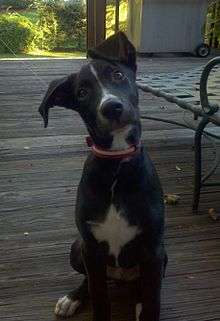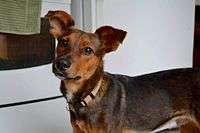Potcake dog
 Black potcake puppy with white markings and curled ears | |||||||||||||||||||||||||
| Other names | Turks & Caicos Potcake, St Lucia Mongrel | ||||||||||||||||||||||||
|---|---|---|---|---|---|---|---|---|---|---|---|---|---|---|---|---|---|---|---|---|---|---|---|---|---|
| Common nicknames | Potcake | ||||||||||||||||||||||||
| Origin |
The Bahamas Turks and Caicos St Lucia Dominican Republic | ||||||||||||||||||||||||
| Breed status | Not recognized as a standardized breed by any major kennel club. | ||||||||||||||||||||||||
| |||||||||||||||||||||||||
| Notes | The Bahamas Kennel Club: listed separately from the mixed-breed dog under Group 9 – Non-Registered | ||||||||||||||||||||||||
| Domestic dog (Canis lupus familiaris) | |||||||||||||||||||||||||
The potcake dog is a mixed-breed dog type found on several Caribbean islands. Its name comes from the congealed peas and rice mixture that local residents traditionally eat, as the rice that cakes to the bottom of the pot would go to the dogs. Although appearance varies, potcakes generally have smooth coats, cocked ears, and long faces. A group of potcakes is known as a parliament.
History
Dogs on various Caribbean islands share a common ancestry; many residents of Turks and Caicos were originally from nearby islands and took their dogs with them.[1] Three types may have contributed to development: dogs the Arawak brought with them to the Bahamas; terriers protecting supplies from rodents on ships that arrived in Eleuthera, New Providence, and the Abaco Islands; and dogs from North Carolina that arrived with Loyalists during the American Revolutionary War period.[1] It is also likely that the early Spanish settlers may have introduced their own dogs. As these could have included fighting dogs, the Arawak dogs may have been killed off. In addition, many breeds were imported in the 20th century which interbred with the local dogs, so making the mix of breeds in the potcake dynamic.[2] DNA studies have shown no residue of early dog DNA in today's potcakes. Any such remaining DNA has become inconsequential due to the constant imports of dogs with the arrival of colonizers.[3]
The type's name is derived from the term "potcake", which refers to the congealed rice mixture at the bottom of the family cooking pot that Bahamians have traditionally fed dogs[4] In Nassau alone, there are an estimated 5,000 to 8,000 stray potcakes.[5] In the late 1970s, The Bahamas named the type the "Royal Bahamian Potcake".[5] As of February 2011, the Bahamas Kennel Club lists it separately from the mixed-breed dog within Group 9 – Non-Registered.[6]
Description
Appearance
Although described as having a "shepherd-mix" look,[7] the potcake dog's appearance varies by island. It may resemble a typical pariah dog or have hound, mastiff, spaniel, terrier, or retriever characteristics.[1] The type typically has cocked ears, a long face, and a smooth coat without undercoat, or less commonly, a "shaggy" or rough coat.[1] As a result of their mixed heritage, potcakes vary widely in terms of color, with many being brown, white, black, and far more with mixed coats. On average, a potcake dog will stand approximately 24 inches (61 cm) at the withers. Healthy dogs typically weigh from 45 to 50 pounds (20 to 23 kg), while strays may weigh only 25 pounds (11 kg).[1]


Behaviour
According to Jane Parker-Rauw, potcake dogs are intelligent, loyal, calm, and resilient. Unlike many dog breeds, potcakes are able to eat many foods that would be upsetting to most dogs. Their stomachs are incredibly hardy. [7][8] However, they tend to wander if not properly confined or supervised.[1]
Overpopulation and rescue efforts
The number of stray potcake dogs on the Turks and Caicos Islands has apparently increased, despite spay-and-neuter programmes designed to minimise their numbers.[7] Because the territory is dependent on tourism, officials consider the dogs nuisances, and police have shot and poisoned them. Strays have a median age of three years.[2] In the Bahamas, misconceptions about spaying and neutering dissuade residents from altering their pets.[9] According to The Bahamas Advocates for Animal Rights group, there are 11,000 unowned dogs in New Providence. Forty five percent of tourists report seeing roaming dogs, and two percent state they were "scared" by their presence.[10]
Local organisations adopt out stray potcake dogs to alleviate the overpopulation problem. In 2005, Turks and Caicos-based rescue organisation Potcake Place became a registered charity. After running out of families to adopt to on Providenciales, volunteers connected with potential adopters through the rescue's website www.potcakeplace.com and Facebook page.[8] Puppies are vaccinated and sent on airlifts free of charge to adopters.[7] Additionally, several no-kill United States shelters accept potcake puppies.[8] The Humane Society of Grand Bahama, located in Freeport, ships them to Florida on ferries.[7]
The canine charity OutPaws airlifted 1,001 potcakes from the Caribbean to Denver, Colorado in 2013, and placed them all for adoption to Colorado families. The 1001st potcake wandered into camp shortly before the take-off of the plane, and was included in the group.
Additional rescue programs exist in Puerto Rico and St. Croix.[11]
Notable dogs
A potcake dog named Amigo is the mascot of the Humane Society of Grand Bahama and the BEKIND Campaign, a collaboration with the HSUS to bring greater attention to animal welfare issues.[12][13] He was also an Ambassador of Hope for homeless animals until his death due to cancer in 2007.[13] Amigo has appeared on MSNBC, Fox News, and CNN, and received the Ambassador of Goodwill and Hollywood Life Breakthrough of the Year 2007 awards.[12][14] In 2009, he was one of four potcake dogs honoured in a series of commemorative stamps.[14]
Potcake dogs Daisy and Dusty, born in Providenciales and owned by Andy LoCascio, are trained to locate fish through scent on the water and distant cries of feeding sea birds. They have been featured on television and in magazines, including Northeast Boating Magazine.[15]
References
- 1 2 3 4 5 6 "What is a Potcake?". Turks and Caicos Society for the Prevention of Cruelty to Animals. 2007. Retrieved 4 April 2011.
- 1 2 (Fielding. Mather & Isaacs, 2005)
- ↑ (Fielding, Ballance & Fielding, 2013)
- ↑ Fielding, Mather & Isaacs, 2005)
- 1 2 Quasha, Jennifer (4 April 2011). "Who Knew: A 'Royal Bahamian Potcake' is a Dog, Not a Baked Good". Animal Planet. Discovery Communications, LLC. Retrieved 14 April 2011.
- ↑ "Breedlist 2011 Feb" (PDF). Bahamas Kennel Club. February 2011. Retrieved 14 April 2011.
- 1 2 3 4 5 McClure, Rosemary (11 June 2008). "Island bliss—and potcake pups—in the Caribbean". Los Angeles Times. Retrieved 14 April 2011.
- 1 2 3 Coffey, Laura T. (28 July 2010). "Aww! Your next pet could be a 'potcake pup'". TODAY Pets & Animals. msnbc.com. Retrieved 4 April 2011.
- ↑ Fielding, William J.; Jane Mather; Maurice Isaacs (2005). Potcakes: Dog Ownership in New Providence, The Bahamas. Purdue University Press. p. 111. ISBN 978-1-55753-334-0. Retrieved 17 April 2011.
- ↑ "Potcakes - New Directions in the Human-Animal Bond" (PDF). Purdue University Press. 2005. Archived from the original (PDF) on 26 September 2015.
- ↑ Rosemary McClure (2008-06-15). "Finding island bliss -- and potcake pups -- in the Caribbean". LA Times. Retrieved 2016-03-23.
- 1 2 "All About "Amigo"". The Humane Society of Grand Bahama. 2009. Retrieved 17 April 2011.
- 1 2 Archived 8 October 2010 at the Wayback Machine.
- 1 2 "About Amigo". Amigo's Fund. 2008. Retrieved 28 April 2011.
- ↑ Schlichter, Tom (1 October 2009). "A Nose for Fish" (PDF). Northeast Boating. Retrieved 11 July 2011.